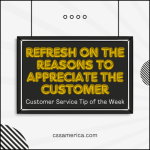
I was in a meeting recently with a client, and we were discussing continuous improvement. Although continuous improvement in most organizations revolves around identifying and fixing issues that are keeping you from being productive, effective, or great at customer service, this organization takes a slightly broader approach.
Along with addressing issues that need to be fixed, they also focus on using continuous improvement to “Strengthen the Strength.” Essentially, the organization encourages staff to identify their strengths and then work to get better and better and better. Similarly, the organization as a whole strives to build on its core competencies and strengths.
Let’s focus on the individual staff perspective. Maybe you’re somebody who is very organized, and yet you’re not very tech savvy. Identify technology solutions that can enhance your organizational skills. There are many apps and software products that are focused on organizing work, projects, brainstorming, social media management, e-mails – virtually any aspect of business.
Let’s assume you’re someone who is highly responsive. That means that you’re responding to all messages with an e-mail reply typically the same day. So how do you strengthen that strength? Maybe you could ensure that along with responding that you’ve received the message, you also convey what next step will occur and by when. Maybe you’re normally communicating back via e-mail the same day because you prefer e-mail, but you begin learning how your clients prefer to communicate, and you begin using their preferred communication method instead.
At the organizational level, you can also use your strength for the greater good. You may be somebody who is very outgoing; use that positive nature to make connections between different divisions of the organization that may not know each other well but that need to know each other well for the organization to perform better.
You may be very analytical; instead of using your analytical ability just in the normal course of your own work, you could volunteer for continuous improvement teams and provide the type of analysis that gets to root causes and potential solutions.
When you think about continuously improving yourself, down just focus on fixing issues.
Strengthen the Strength.
Signup for FREE Tips! Contact Us More Resources for You Visit Our Home Page























